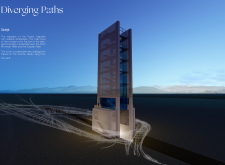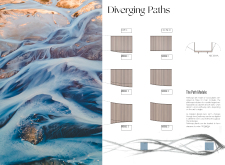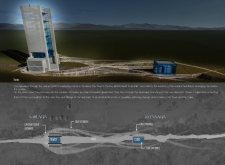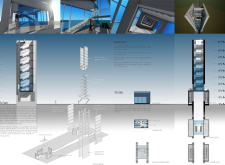5 key facts about this project
The project functions primarily as an observation and experiential platform, allowing users to engage with the dramatic Icelandic landscape from varying elevations and perspectives. The tower serves as a visual anchor, offering panoramic views that frame the geological phenomena of the region. Meanwhile, the pathways facilitate movement and exploration, reflecting the adaptability of natural waterways as they interact with their surroundings. The integration of natural and built environments enhances the overall user experience, promoting a deeper understanding of the landscape.
Materiality plays a critical role in the architectural design. The use of concrete and glass creates a solid and transparent façade for the tower, emphasizing its rugged presence while allowing natural light to permeate the structure. The pathways are constructed with modular wooden elements, which enable flexibility in shaping the user experience. This adaptability is unique, as it mirrors the unpredictability found in nature, allowing the design to evolve alongside the environment. The incorporation of volcanic rock not only integrates local materials into the project but also reinforces its commitment to contextual design.
Sustainability is a cornerstone of this project, showcasing innovative systems that align with the ecological principles of the surrounding area. Geothermal heating maximizes energy efficiency, reflecting Iceland's commitment to renewable resources. Additionally, rainwater collection systems are embedded within the design to promote water reuse, further highlighting the project's consideration for environmental impact. These systems not only serve functional purposes but also educate users about sustainable practices.
The design approach taken in "Diverging Paths" emphasizes the relationship between architecture and the geological context. Rather than imposing a structure onto the landscape, the project engages with the existing natural elements, responding dynamically to topography and environmental factors. This approach highlights a growing trend in architecture where ecological sensitivity and adaptability are prioritized, positioning "Diverging Paths" distinctively among similar projects.
For a deeper understanding of the architectural strategies employed, readers are encouraged to explore the architectural plans, sections, and designs presented in the project's materials. This provides insights into how the elements come together to form a cohesive and responsive architectural narrative.


























